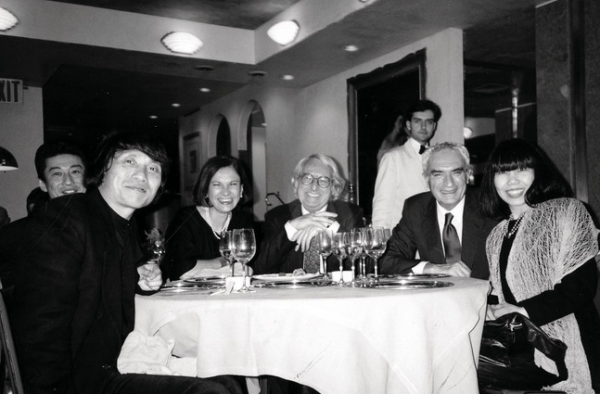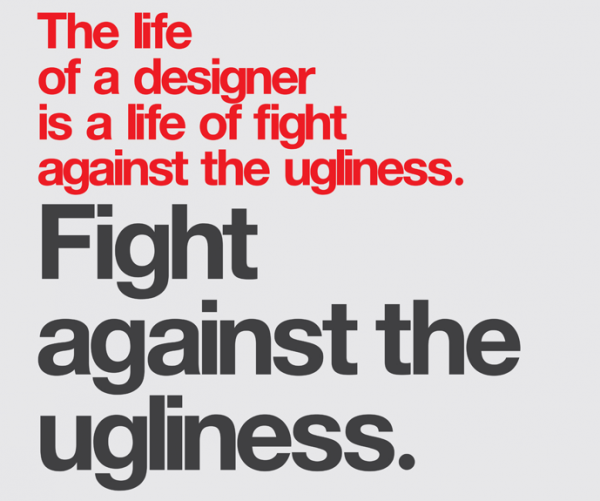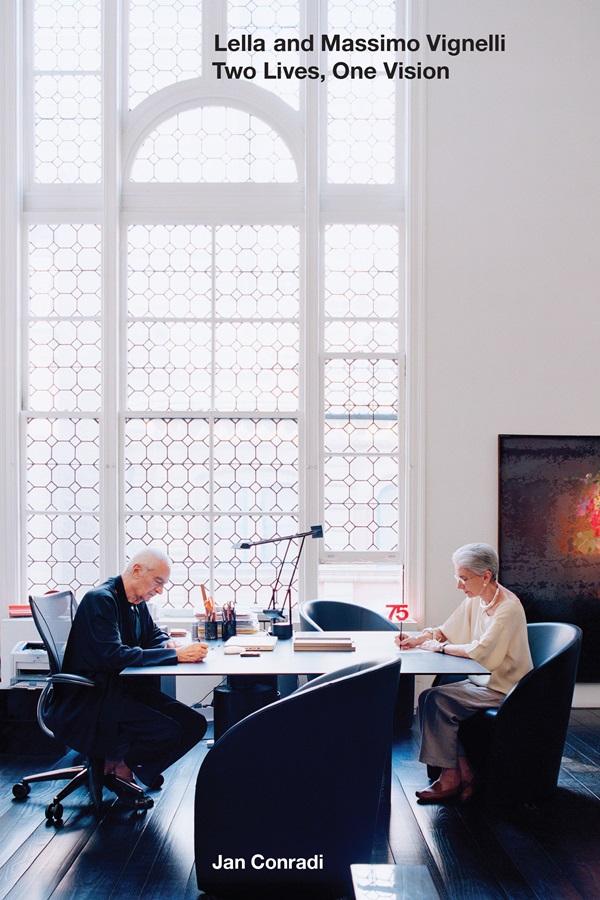People
Design’s Power Couple: Lella and Massimo Vignelli
How the designers won the fight against ugliness and shallowness.

How the designers won the fight against ugliness and shallowness.

Jan Conradi


Two of the world’s most influential designers, Lella and Massimo Vignelli shaped our world and their world, together. They left their mark on everything from silverware, watches, chairs, and stacking tableware to Venini lamps, the Bloomingdale’s bag, the New York subway map, and the National Park Service. Critic Paul Goldberger named them “total designers” who could work as nimbly in 2-D as in 3-D.
Young designers still revere them and their generosity with knowledge—and young and old alike mourn the death of Massimo, who died at the end of May at age 83 (see: “Designer Massimo Vignelli, 1931–2014“).
As chair of the nonprofit La FondazioneNY, devoted to promoting cultural cooperation between Italian and American artists and scientists, Massimo Vignelli helped strengthen a new bridge between America and Italy while giving voice to the Slow Design movement.
Architects worldwide—among them, Richard Meier and Peter Eisenman—look to the work of the Vignellis as examples of the gold standard. In 2011 the pair received the President’s Medal from the Architectural League of New York, one of many awards received over the years. In 2012 the documentary Design is One: Lella & Massimo Vignelli was released.
Design scholars are familiar with the Vignelli Center for Design Studies, which houses the Vignelli archives at the Rochester Institute of Technology in upstate New York. Among the trove there, in Box 333 of the Massimo and Lella Vignelli papers, is the MTA Graphics Standards Manual—the New York City Transit Authority Graphics Standards Manual for the subway system (see: “Kickstarter Project To Reissue Massimo Vignelli’s Masterpiece“). Especially when down underground, it’s important to remember that good design—and beauty—can triumph.
artnet News salutes this power couple and, with a nod to the best design being presented this fall season in New York and other cosmopolitan cities, we offer an excerpt from the recently published book Lella and Massimo Vignelli: Two Lives, One Vision, by Jan Conradi.

From left: Tadao Ando, Lella Vignelli, Richard Meier, and Massimo Vignelli, in January 1990.
Photo via: Architectural Record, courtesy Richard Meier & Partners Architects.
The Fight against Ugliness
The Vignellis maintain a steadfast insistence on the validity of modernism, and their particular brand of it blends European tradition with American pragmatism. “The critics of modernism misunderstand. It is not a style issue, it is a moral issue,” said Massimo. “It is imperative that design lasts a long time, as long as the material itself has integrity or until technical areas improve or change. Culture is important. Anything with value should be protected, whether it is a building, a package, or a bottle. These are the testimonials of a culture. Sometimes we protect things that are not timeless, but trendy; these are an expression of a particular time. We should not protect trash. People who understand this, who are critically motivated, should be making the decisions.”
If they don’t specify exactly who should be making design decisions, the Vignellis are clear that marketing personnel should not have this power. The topic always launches Massimo into an impassioned tirade. After leaving Vignelli Associates, designer Janice Carapellucci, remained in contact with her former employers. In 1994, she sent a letter, writing, “I miss you, Massimo, but you are with me every day. Thank you for preparing me so well… Did you catch this editorial blasting those marketing people?”16 She attached a page from The New York Times. The headline shouted, “Marketers, Stop Your Tinkering,” and the article offered a lively critique of the shortcomings of American marketing.
There is seemingly no end to this subject, or to the frustrations of seeing good design solutions bypassed or replaced for frivolous reasons. Paul Rand once wrote, “Persons unqualified to make design judgments are frequently shifted into design-sensitive positions. The position of authority is then used as evidence of expertise… At issue is not the right, or even the duty, to question, but the right to make design judgment. Such misuse of privilege is a disservice to management and counterproductive to good design.” He concluded, “The plethora of bad design that we see all around us can probably be attributed as much to good salesmanship as to bad taste.” 17
Massimo has often said that a good design solution should be timeless; it should last until the problem changes. Unfortunately, that advice is often ignored. Good design solutions are often diminished by poor management and caretaking, or abandoned for reasons that have nothing to do with design value. Sometimes there is an uproar when this happens, but it can be difficult to know how much of the noise is critically motivated and how much is a result of a crowd-sourced mentality that presumes all responses have equal validity.
Design criticism is increasingly treated as a spectator sport, but architects and designers were condemning that practice long before current technologies made it easier to crowd out reasoned analysis through quick tweets and shallow messages. Just as design by committee rarely achieves concise solutions, critique arising from cacophony should be handled with caution. It has promoted poor design more than it has protected good work; the irony is that articulating this reality usually results in accusations of elitist design snobbery.
Sifting through all the noise allows one to pan for nuggets of enlightening critical commentary. In 2013 American Airlines announced a redesign that replaced the Vignelli identity program created in 1967. Critic Paul Goldberger condemned the new approach. He noted that the airline was in Chapter 11 bankruptcy proceedings. “So it’s no wonder that somebody at American thought it would be a great idea to call up Future Brands—yes, that is the tellingly generic name of the design-and-consulting firm that came up with all of this—and ask them to give the airline a new image,” he wrote. The company’s management “somehow got the idea that the best way to deal with the struggles it has been having with its labor unions, its passengers, its rivals, and its investors was to change the way its planes look.”18
Massimo said, “This is the typical mistake that company presidents make: ‘I’ll change the logo, and the company will look new and people will forget the company’s problems.’” Public opinion has generally agreed that this change is not a good idea, with commentary about a “big waste of money by a company in bankruptcy” and observations that fixing the company image by “improving passenger experiences” would be a better place for management to focus its efforts. A cosmetic makeover is superficial styling—a use of design that the Vignellis abhor because it does not address inherent and important issues for the company and its clientele.
The Vignellis urge others to think carefully not only about what they are creating, but about how and why a solution arises. Massimo said, “There is a big difference between the people who ask why? and the people who say why not? Why? implies depth; people who ask ‘why’ are looking for structure, for what is good. To begin from why not? is a sign of chaos.”
“We work through a process; it is the backbone of our methodology,” said Massimo. “There is a process of thinking: examining, sifting, digging, exploring until you get down to the thing that is just right. It is very different from just finding something and saying ‘How about this? How about that?’ Sometimes you can do that; sometimes we discover by happenstance, but a lot of people get seduced by happenstance and that is a very different thing. That is the culture of the found object as opposed to the culture of the designed object.”
Massimo continued, “Don’t get me wrong. There are positive aspects even of the found object. You found it when your mind was focused on something; when you were thinking in a certain way. A thousand people went by that same thing and they didn’t see it. It is not that it is a wrong way of working, it is a different way of working. Our way is more analytical; the other way is more happenstance. It takes a trained eye to see that happenstance and to see its value.”
Massimo made the previous statement in 2006. It is consistent with comments he made years earlier. In 1993, he wrote a personal letter that challenged a leading American graphic designer, saying, “I see your sense of cultural responsibility being taken over by your desire to be different at any cost… In our culture and society, typographical refinement and design responsibility still have a long way to go. I know your intent is more noble than it looks and I respect it, but the form it takes is highly irresponsible since it breeds shallowness in the name of newness.”19

The book cover of Lella and Massimo Vignelli: Two Lives, One Vision, by Jan Conradi (Rochester: RIT Press, 2014).
16 Janice Carapellucci, interview, July 12, 2013.
17 Paul Rand, Paul Rand: A Designer’s Art (New Haven: Yale University Press, 1985), p. 234.
18 Vanity Fair, “Something Lousy in the Air: Analyzing American Airlines’ Disastrous Redesign,” Paul Goldberger, January 22, 2013, (accessed August 7, 2013).
19 Massimo Vignelli, letter to Laurie Haycock Makela, June 22, 1993 (Vignelli Archives).
Excerpted from Lella and Massimo Vignelli: Two Lives, One Vision, by Jan Conradi. Copyright © 2014 Jan Conradi and Rochester Institute of Technology. Reprinted by permission from RIT Press.